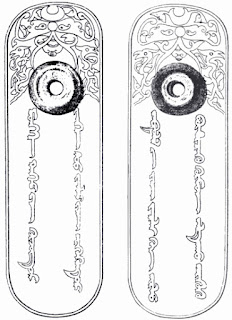Item Code : 48
Year
|
2008
|
Obverse
|
Chinthe lion in a coin. Paiza (Gerege) a tablet of authority for the
Mongol officials and envoys. This enabled the Mongol nobles and officials to
demand goods and services from civilian populations.
|
Reverse
|
Soyombo – the national symbol of Mongolia
|
Watermark
|
Portrait of Genghis Khan
|
Obverse description
The Chinthe is a leogryph (lion-like creature)
that is often seen at the entrances of pagodas and temples in Burma and other South and Southeast Asian countries. The chinthe is
featured prominently on the kyat (the currency of Burma) and
theSri Lankan rupee. The chinthe is almost
always depicted in pairs, and serve to protect the pagoda. They typically
appear as animals, but are sometimes found with human faces.
 |
A Gerege in Mongolian script, found in the former territory of the Mongol Golden Horde(Dnieper River, 1845)
|
A paiza or paizi or gerege was a tablet carried by Mongol officials and envoys to signify certain
privileges and authority. They enabled Mongol nobles and officials to demand
goods and services from civilian populations.
Although only someone with a paiza was required
to be supplied with mounts and served specified rations, those carrying
military rarities used the yam even without a paiza. The officials and nobles
of the Mongol Empire issued paizas unofficially and abused civilians.
Therefore, Ögedei Khan (r. 1229–1241) prohibited the nobility from issuing paizas and jarliqs
Watermark description
Genghis Khan (c. 1162 – August 18, 1227) was one of the
world's most powerful military leaders, who joined with the Mongol tribes and started the Mongol Empire. He was a Mongol Emperor who was very
successful in battle, conquering many other peoples such as the Jin Dynasty. He
was a very strong and powerful emperor who occupied much of China and some
surrounding countries of China. His children and his grandchildren started the
largest empire in the world. Genghis Khan's grandson, Kublai Khan, was the first ever emperor of the Yuan Dynasty (1271–1368) in China.
Genghis Khan's real name was Temüjin which means ironworker. Because of his military success people
referred to him as Genghis, meaning "Universe ruler". Many people
were killed by his armies and he gained a reputation as a "brutal
monster". Genghis Khan died in the Liupan Mountains in northwestern China,
in Aug. 1227. His burial
site is unknown.
ജെങ്കിസ് ഖാൻ
മംഗോൾ സാമ്രാജ്യത്തിന്റെ സ്ഥാപകനും ഖാനും(ഭരണാനാധികാരി) ഖാഗനും
(ചക്രവർത്തി) ആയിരുന്നു മംഗോൾ വംശജനായ ജെങ്കിസ് ഖാൻ. ആദ്യനാമം ടെമുജിൻ (കൊല്ലൻ
എന്നർത്ഥം) എന്നായിരുന്നു. സമീപസ്ഥങ്ങളായ
പ്രദേശങ്ങളെ മാത്രം ഉൾക്കൊള്ളുന്ന ലോകത്തിലെ ഏറ്റവും വലിയ സാമ്രാജ്യമായിരുന്നു മംഗോൾ സാമ്രാജ്യം.
തെമുചിൻ എന്നായിരുന്നു ചെങ്കിസ് ഖാന്റെ ആദ്യ നാമം. തന്റെ 44-ആം വയസിലാണ് തെമൂചിൻ, ഓങ്ഖാനെ സ്ഥാനഭ്രഷ്ടനാക്കി ചെങ്കിസ്
ഖാൻ എന്ന പേരിൽ മംഗോളിയൻ വംശജരുടെ നേതാവായത്. വടക്ക്
കിഴക്കൻ ഏഷ്യയിലെ പല പ്രാകൃതഗോത്രങ്ങളെ ഏകീകരിച്ചുകൊണ്ട് 1206-ൽ ചെങ്കിസ് ഖാൻ എല്ലാ
മംഗോളിയരുടേയും അധിപനായി (ഖാൻ). ഉടൻ തന്നെ ചൈനയടക്കം സമീപദേശങ്ങളിലെ
ഇതരജനവിഭാഗങ്ങളെ കീഴടക്കാനായി ചെങ്കിസ്ഖാൻ പുറപ്പെട്ടു. ഖാൻ ആയി
പ്രഖ്യാപിക്കപ്പെട്ടതിനു ശേഷം ഏഷ്യയുടെ കിഴക്ക്, മദ്ധ്യ ഭാഗങ്ങളിലേക്ക്
അധിനിവേശം നടത്തിക്കൊണ്ട് ആക്രമണോത്സുകമായ ഒരു വിദേശനയം പിന്തുടർന്നു.
ഇദ്ദേഹത്തിന്റെ കാലഘട്ടത്തിൽ ഏഷ്യയിലെ ഭൂരിഭാഗം പ്രദേശങ്ങളും മംഗോൾ
സാമ്രാജ്യത്തിന്റെ കീഴിലായി.





No comments:
Post a Comment